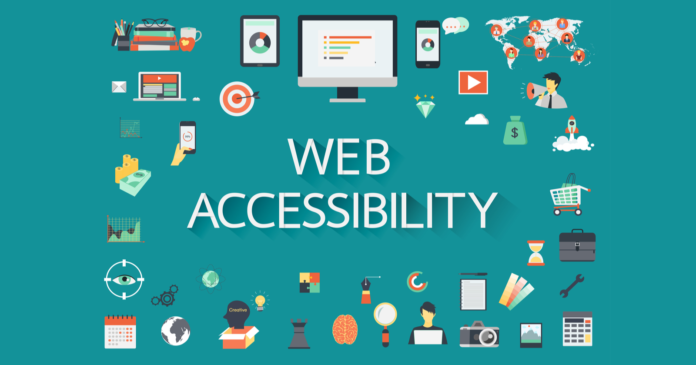
A strong online presence is important for the success of any business. However, amidst the rush to create visually appealing websites, it’s easy to overlook the importance of accessibility for individuals with visual impairments. Making your business website accessible for the visually impaired aligns with ethical business practices and opens up your products or services to a wider audience. This article examines the significance of web accessibility, key challenges visually impaired users face, and practical strategies to ensure your website is inclusive and user-friendly. Keep reading to learn more.
Understanding the Importance of Web Accessibility
Web accessibility refers to the designing and development of websites that can be used and navigated by people with disabilities, including those with visual impairments. Having an accessible website is a legal requirement in many regions and an ethical obligation that fosters inclusivity and equal access to information. When your business website is accessible, it benefits visually impaired users and enhances the user experience for everyone.
Challenges Faced by Visually Impaired Users

Visually impaired users encounter various challenges when navigating the internet. Knowing these challenges is crucial for designing a website that caters to their needs. Some of the key obstacles include:
- Screen Readers Compatibility: Screen readers are essential tools for visually impaired users, converting digital text into synthesized speech. However, not all websites are compatible with screen readers, leading to a disjointed and frustrating user experience.
- Inadequate Text Descriptions: Images play a significant role in web content, but they can be a barrier for visually impaired users if not accompanied by descriptive text. Inadequate alt text or image descriptions prevent users from understanding the content and context.
- Complex Navigation: Overly complex navigation structures can be overwhelming for visually impaired users. Websites with intricate menus, unclear headings, or lack of proper organization can make it challenging for users to find and access the information they need.
- Small Font Sizes and Low Contrast: Small font sizes and low-contrast text can be difficult for individuals with visual impairments to read. Ensuring legible text with appropriate contrast is essential for a positive user experience.
- Inaccessible Forms and Interactive Elements: Forms and interactive elements, such as buttons and dropdown menus, can pose difficulties if not designed with accessibility in mind. Providing clear instructions and making interactive elements accessible through keyboard navigation is essential.
Practical Strategies for Web Accessibility

Now that you understand the challenges faced by visually impaired people, let’s explore practical strategies to make your business website accessible:
- Prioritize Semantic HTML: Use semantic HTML elements to structure your web content logically. Properly ordered headings, lists, and paragraphs assist screen readers in interpreting and conveying information accurately. Semantic HTML not only enhances accessibility but also improves SEO.
- Provide Descriptive Alt Text: Ensure that all images on your website have descriptive alternative text (alt text). Alt text gives a textual description of images, helping visually impaired users understand the content. Use concise and meaningful descriptions for each image.
- Implement ARIA (Accessible Rich Internet Applications) Landmarks: ARIA landmarks are HTML attributes that define regions of a page, making it easier for screen reader users to navigate. Incorporate landmarks such as banners, navigation, and main content areas to enhance the overall structure of your website.
- Optimize Navigation: Simplify and optimize your website’s navigation. Clearly label menus and use consistent navigation structures across pages. A well-organized website makes it easier for all users, including those with visual impairments, to find relevant information. You can do this and everything else in this list with the right choice of overlays. Learn about overlay facts here.
- Ensure Keyboard Accessibility: Some users rely on keyboards instead of traditional mice for navigation. Make sure all interactive elements and forms can be accessed and operated using a keyboard. This ensures that individuals with motor disabilities or visual impairments can navigate your site effectively.
- Use High-Contrast Colors and Legible Fonts: Choose high-contrast color schemes to enhance visibility. Ensure that text is legible by using clear fonts and maintaining an appropriate font size. Try not to use color alone to convey information; use additional cues such as text labels or symbols.
- Test with Screen Readers: Regularly test your website using popular screen readers to identify and address potential accessibility issues. Familiarize yourself with how screen readers interpret your content and make required adjustments to improve the user experience.
- Offer Text-to-Speech Functionality: Consider incorporating text-to-speech functionality on your website. This feature enables users to listen to the content, providing an alternative method of accessing information for those with visual impairments.
- Provide Transcripts for Multimedia Content: For multimedia content such as videos and podcasts, offer transcripts. Transcripts benefit visually impaired users and enhance the overall user experience by providing a text-based alternative to audio or video content.
- Regularly Update and Maintain Accessibility Standards: Web standards and guidelines for accessibility evolve. Stay informed about the latest accessibility standards, and regularly update and maintain your website to ensure ongoing compliance with these standards.
- Include User Feedback Mechanisms: Actively seek feedback from users, including those with visual impairments, to identify potential accessibility challenges and areas for improvement. Use your website to incorporate user testing and feedback mechanisms, such as surveys or contact forms. This demonstrates your commitment to continuous improvement and allows you to address specific user needs and enhance the overall accessibility of your site based on real user experiences. By involving the visually impaired community in the feedback process, you can gain valuable insights and make targeted adjustments to ensure your website remains inclusive and user-friendly for everyone.

Conclusion
Ensuring your business website is accessible for the visually impaired is not just a legal requirement; it’s a commitment to inclusivity and equal access. By implementing the practical strategies outlined in this article, you can create a website that caters to a diverse audience, providing a positive and seamless user experience for all. Web accessibility is not only a responsible business practice but also a pathway to unlocking the full potential of your online presence.
















